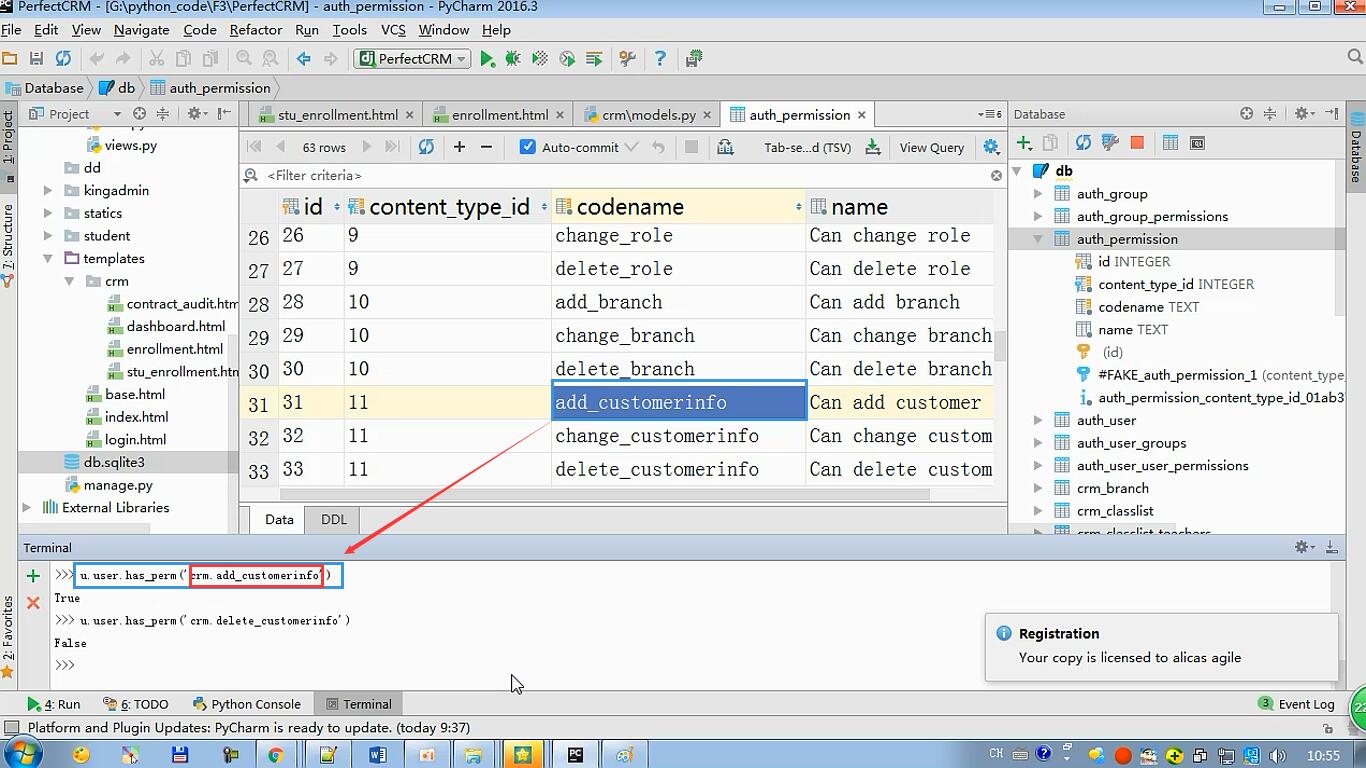一:admin下的权限了解
(一)默认权限表是在自带auth模块,中permission表中
可以使用has_perm方法获取用户是否有这个权限
(二)Django自定义权限
(1)添加表
from django.db import models from django.contrib.auth.models import ( BaseUserManager, AbstractBaseUser,PermissionsMixin
#BaseUserManager 用户管理基类,用于创建用户
#AbstractBaseUser 抽象类,声明一些必须字段,不会自己生产表,继承的子类才会,主要内容:class Meta abstract=True
#PermissionMixin 权限管理类,也是抽象类 ) class MyUserManager(BaseUserManager): #用于创建用户,需要在settings文件中声明 def create_user(self, email, name, password=None): """ Creates and saves a User with the given email, date of birth and password. """ if not email: raise ValueError('Users must have an email address') user = self.model( email=self.normalize_email(email), name=name, ) user.set_password(password) user.save(using=self._db) return user def create_superuser(self, email, name, password): """ Creates and saves a superuser with the given email, date of birth and password. """ user = self.create_user( email, password=password, name=name, ) user.is_superuser = True user.save(using=self._db) return user class UserProfile(AbstractBaseUser,PermissionsMixin): email = models.EmailField( verbose_name='email address', max_length=255, unique=True, ) name = models.CharField(max_length=128) is_active = models.BooleanField(default=True) is_staff = models.BooleanField(default=True) # is_admin = models.BooleanField(default=False) #其中is_admin没有作用,is_superuser才是设置超级用户 role = models.ManyToManyField("Role",blank=True) #,null=Truenull has no effect on ManyToManyField.,null对于manytomanyfield无作用,会报警 objects = MyUserManager() #用户管理类和自定义用户表关联 USERNAME_FIELD = 'email' REQUIRED_FIELDS = ['name'] def __str__(self): return self.email def get_full_name(self): return self.email def get_short_name(self): return self.email
(2)settings文件中设置
AUTH_USER_MODEL = 'repository.UserProfile'
(3)在admin文件中设置展示内容
from django import forms from django.contrib import admin from django.contrib.auth.models import Group from django.contrib.auth.admin import UserAdmin as BaseUserAdmin from django.contrib.auth.forms import ReadOnlyPasswordHashField from repository.models import UserProfile class UserCreationForm(forms.ModelForm): #创建时显示的表单信息 """A form for creating new users. Includes all the required fields, plus a repeated password.""" password1 = forms.CharField(label='Password', widget=forms.PasswordInput) password2 = forms.CharField(label='Password confirmation', widget=forms.PasswordInput) class Meta: model = UserProfile fields = ('email', 'name') def clean_password2(self): #对字段进行验证 # Check that the two password entries match password1 = self.cleaned_data.get("password1") password2 = self.cleaned_data.get("password2") if password1 and password2 and password1 != password2: raise forms.ValidationError("Passwords don't match") return password2 def save(self, commit=True): # Save the provided password in hashed format user = super().save(commit=False) user.set_password(self.cleaned_data["password1"]) if commit: user.save() return user class UserChangeForm(forms.ModelForm): #修改时显示的表单信息 """A form for updating users. Includes all the fields on the user, but replaces the password field with admin's password hash display field. """ password = ReadOnlyPasswordHashField() #密码字段显示时是hash加密只读字段 class Meta: model = UserProfile fields = ('email', 'password', 'name', 'is_active', 'is_superuser') def clean_password(self): # Regardless of what the user provides, return the initial value. # This is done here, rather than on the field, because the # field does not have access to the initial value return self.initial["password"] class UserProfileAdmin(BaseUserAdmin): #用于注册的表类 # The forms to add and change user instances form = UserChangeForm add_form = UserCreationForm # The fields to be used in displaying the User model. # These override the definitions on the base UserAdmin # that reference specific fields on auth.User. list_display = ('email', 'name', 'is_superuser') list_filter = ('is_superuser',) fieldsets = ( #用于修改 (None, {'fields': ('email', 'password')}), ('Personal info', {'fields': ('name',)}), ('Permissions', {'fields': ('is_active','is_staff','is_superuser','role','user_permissions','groups',)}), ) # add_fieldsets is not a standard ModelAdmin attribute. UserAdmin # overrides get_fieldsets to use this attribute when creating a user. add_fieldsets = ( #用于添加 (None, { 'classes': ('wide',), 'fields': ('email', 'name', 'password1', 'password2')} ), ) search_fields = ('email',) ordering = ('email',) filter_horizontal = ('role','user_permissions',) # Now register the new UserAdmin... admin.site.register(UserProfile, UserProfileAdmin) # ... and, since we're not using Django's built-in permissions, # unregister the Group model from admin. admin.site.unregister(Group)